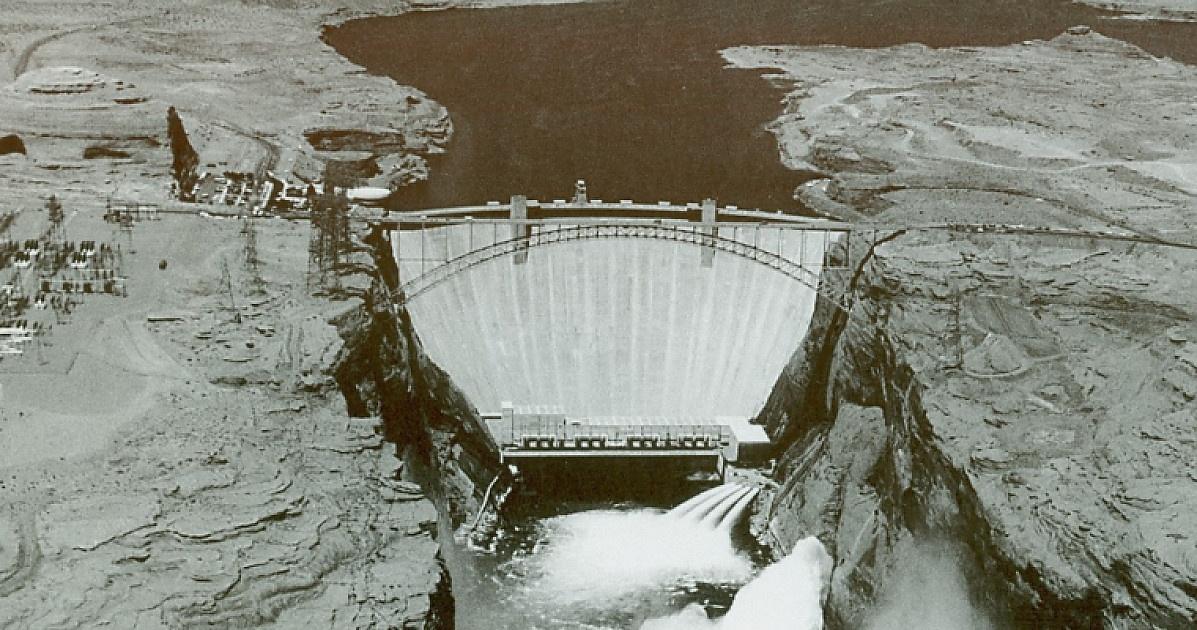
Glen Canyon: A Dam, Water, and the West
Original Airdate: October 1999
In an isolated spot on the Utah-Arizona border during the 1950s, the great Western issues of water and progress would play out in dramatic fashion against the timeless flow of the Colorado River.
One of the largest construction projects in human history had begun, and the face of the American West would be changed forever. Glen Canyon Dam would create one of the world's largest man-made bodies of water, while at the same time drowning a thousand years of human history...and a million years of natural history. It was the future of the West, a story of winners and losers, of the politics of power, and of the few who stood in the way.
Glen Canyon: A Dam, Water, and The West uses archival photographs, film, and interviews with the key players involved in the dam's construction to present a balanced examination of Western progress. The one-hour documentary was produced and directed by Ken Verdoia. Nancy Green served as associate producer.
Straddling the Utah-Arizona border, the Glen Canyon Dam rises over 700 feet from solid bedrock to block the flow of the Colorado River. Behind its wall of five-million yards of concrete are the waters of Lake Powell. Storing enough water to meet the needs of almost thirty million families for a year, it is one of the largest man-made reservoirs in the world.
Some three million people a year visit the dam and Lake Powell, the more than 100-mile- long reservoir that fills the stark corner of the Colorado Plateau. Those visitors leave an estimated $500 million dollars behind each year, fueling dozens of small town economies, like the one in Page, Arizona. Just slightly more than a generation ago the town, the tourists and their money, the lake and the dam did not exist.
"Glen Canyon is not just the story of a dam and the making of a lake. It is the story of the American West in the years after World War II. It is the story of how public policy is shaped, how the values of an era can manifest themselves in the projects government undertakes in our name as citizens and taxpayers," says Ken Verdoia.
The program offers a comprehensive history of the dam, from early compromises between the government and environmental activists to archeological efforts to document the history of Glen Canyon. Teams from the Museum of Northern Arizona and the University of Utah raced against time to salvage artifacts for future generations to study. But ancient Indian dwellings and rock art were inevitably lost to the rising waters of Lake Powell.
In the spirit of public television's commitment to objective reporting, Glen Canyon: A Dam, Water, and The West explores without bias the dam and its dramatic reshaping of the Western landscape. "Any two people with different interests can view the program and come to different conclusions about what constitutes progress in the West," says Verdoia. "The documentary has very little to do with the groups calling for the draining of Lake Powell. Rather, it has everything to do with helping the public understand that water is one of the pivotal issues that shapes life in the Great Basin and Southwest."
Illuminating both sides of the debate over use and development of natural resources, Glen Canyon features interviews with two key players: David Brower, director of the Sierra Club during the 1950s and Floyd Dominy, the Commissioner of the Bureau of Reclamation during the dam's construction. "Each is a person of deep conviction. Each has the courage of those convictions. While not yielding an inch of ground to the other on principle, they have fashioned a rough understanding of each other that has to be characterized as respect. These two men were lions in a different time, and their work has shaped the world we live in today," says Verdoia.
Glen Canyon: A Dam, Water, and The West demonstrates how, as the West continues to develop, water issues will remain. The Glen Canyon Dam stands as a symbol for both past and future, where memories of the past still clash with visions of progress. It is a place in the West that can uniquely encourage both views.
Verdoia hopes that viewers will ultimately gain insight into Glen Canyon's past and present. "I hope a viewer might look at the program and develop an appreciation for the beauty and history that existed in Glen Canyon before the building of the dam. I hope they would respect and appreciate the labors of those who built this extraordinary public works project."
STREAM ANYTIME, ANYWHERE
